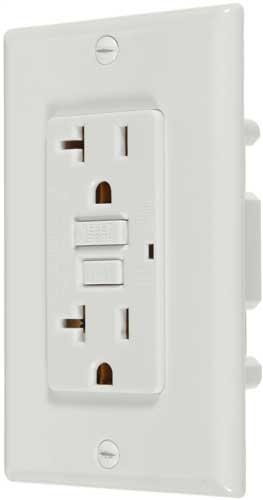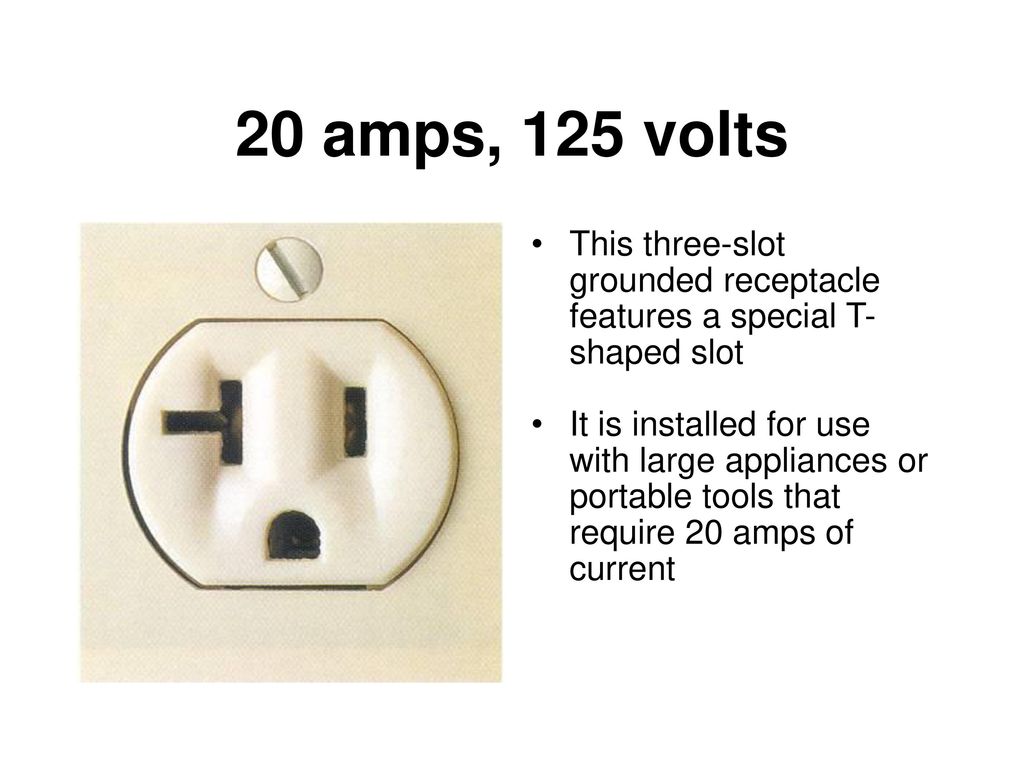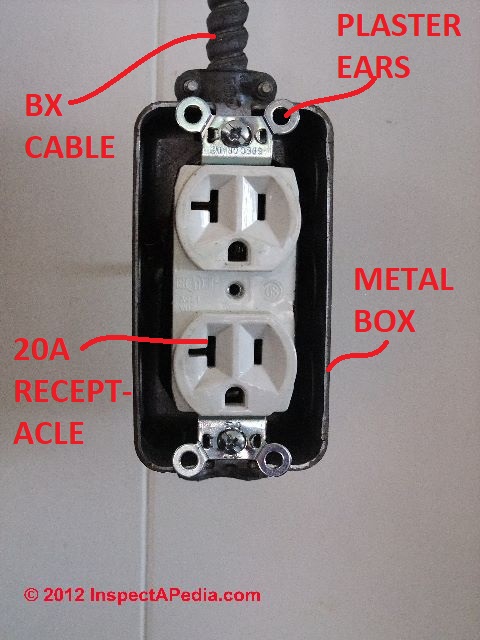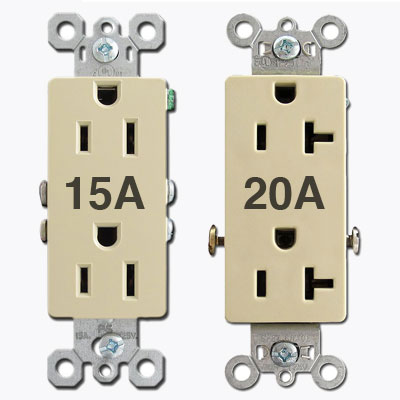T Slot Receptacle
The NEMA 5-20R (T-Slot) is a 3 wire grounded connector rated up to 125VAC and 20A. The 5-20R T-Slot receptacles are often used when 20A circuits are installed due to flexibility of being downward compatible with the 5-15P. The Receptacles are the defacto power supply for all of North America. The reason why its called a “t-shaped neutral” is because, as you can see in the photo above, the neutral is the larger of the two inputs and it has a slot sticking out of it that shapes it into a T. This makes it easy to spot when you are on a location/tech scout. You'll notice that the heavier-duty 20-Amp electrical receptacle has that T-slot at it's wider connection opening - an easy way to identify a wall receptacle rated for 20-Amps - provided that the receptacle was properly matched to the wire size and the circuit breaker or fuse size. The T-shaped slot indicates that the 120-volt receptacle is rated for 20-amps. Regular wall receptacles with a pair of vertical slots are rated for only 15-amps, but the T-shape enables it to accept either a 15- or 20-amp plug.
Hey all,
Just wanted to do a quick post about these “t-shaped neutral” outlets. They are important to know about and you should keep an eye out for these on location shoots (I did not know the significance until just the other day, whoops!).
When you look at a typical household outlet (called the Edison 5-15), you’ll see this:
This particular receptacle is rated for 15amps at 115volts. Most households have a couple of 20A circuits located in the more power-hungry sections(kitchen, bathroom, laundry room, etc).
I recently had the pleasure of learning first hand what can happen to the hubbell(male/female connectors located at end of a stinger) and the receptacle itself when it’s overloaded (it gets charred and breaks and it smells like ass!). As a 2K tungsten fixture draws 17.4A, you are putting strain on your 15A receptacle (as seen above), even if it is on a 20A circuit.
/cdn.vox-cdn.com/uploads/chorus_asset/file/20096019/iStock_115981297.jpg)
This is the “t-shaped neutral” 20A receptacle(called the Edison 5-20):

When you have an Edison outlet you can have two different kinds of straight connectors, polarized and non-polarized (for the most part you will see 3 different types of outlets, the two I have pictured here and then one of the much older receptacles that has no ground/is non-polarized). The non-polarized outlet has the neutral and the hot (the two straight connectors) being the same size whereas in the polarized version, the neutral is the visibly larger straight connector(the hot is smaller). The reason why its called a “t-shaped neutral” is because, as you can see in the photo above, the neutral is the larger of the two inputs and it has a slot sticking out of it that shapes it into a T. This makes it easy to spot when you are on a location/tech scout. It’s important to note where or if you have these because they can handle the 2K’s load without melting.
“T-shaped neutrals” are mostly used for commercial floor buffers, vacuums and such, which is why they are typically found in commercial buildings.
There is a lot more info out there about these kinds of small yet important things and if you want to know more, send us an email at gaffersuniteinfo@gmail.com.
Cheers!
Peter Mosiman
Why do some receptacle outlets have a T-shaped hole?
Sunday, August 23, 2020
20a T-slot Gfci Receptacles
The T-shaped slot indicates that the 120-volt receptacle is rated for 20-amps. Regular wall receptacles with a pair of vertical slots are rated for only 15-amps, but the T-shape enables it to accept either a 15- or 20-amp plug.
This receptacle configuration is called a NEMA 5-20R, a standard created by the National Electrical Manufacturers Association, and it accepts a NEMA 5-20P plug like the one shown below.

• • • • • • • • • • • • • • • • • • • • • • • • • • •
To learn more about electrical wiring, devices, and receptacles, see these other blog posts:
• What is the difference between what trips a GFCI (ground fault) receptacle and a circuit breaker?
• What is the code requirement for GFCI protection for receptacles near a wet bar sink?
• What is the requirement for a service receptacle outlet for heating, air conditioning, and refrigeration (HACR) equipment?
• Why is an opening in the wall around the side of an electrical receptacle outlet a safety defect?
• When was GFCI-protection for kitchen dishwasher receptacle outlet first required?
• What is allowable voltage range at a wall receptacle outlet in a house?
• When should I replace electric receptacle outlets?
• Does an electric receptacle outlet in a storage shed require GFCI protection?
• What are 'self-contained' electrical receptacle outlets and switches?
• What is the difference between an electrical receptacle, an outlet, and a plug?
• Does a washing machine receptacle outlet require GFCI protection?
• What is the building code requirement for receptacle outlets at stairs and stair landings?
• Can I remove a 240-volt range receptacle and hard-wire the range?
• What is a 'backstab' receptacle outlet?
• Why are some electric receptacle outlets upside down (ground slot up) in a house?
• What is the height requirement for an electric receptacle outlet?
• Where are GFCI receptacle outlets required?
• When were GFCI receptacle outlets first required?
• Does a home inspector remove receptacle outlet cover plates?
• What is the minimum height for an exterior receptacle outlet?
• When was the current receptacle/outlet spacing of 12-feet first required?
• When was the three-slot (grounding) outlet/receptacle first required?
• Why does painting an electric receptacle (outlet) make it unsafe?
• Why are electrical outlets and plugs polarized?
• How many electrical receptacles (outlets) are required in a hallway?
• What problems does having too many electric receptacle outlets on a single circuit cause?
• Is a house required to have outdoor electric receptacle outlets?
• How I can tell if a receptacle outlet is tamper resistant?
• Why is there a GFCI breaker in the electric panel for the bathroom shower light and exhaust fan?
• What is a false ground, bootleg ground, or cheated ground receptacle?
• How can adding wood paneling or a wainscot create an electrical safety hazard?
• How can I figure out what a mystery wall switch does?
• How far apart should kitchen counter receptacles be spaced?
• How far above a kitchen countertop do electrical outlets have to be?
• What is reversed polarity at an outlet/receptacle? Why is it dangerous?
• How high above the floor do electric outlets/receptacles in a garage have to be?
• How far apart should electric receptacles be spaced in a bathroom?
• Is an ungrounded electric receptacle outlet dangerous?
• My bathroom electric receptacle/outlet is dead and there are no tripped breakers in the electric panel. What's wrong?

• Is there an adapter that can be placed on a two-slot receptacle to make it safe?

• How do the new tamper-resistant electric outlets work?
• Why is there no bathroom electric receptacle in this old house?
T Slot Receptacle Box
• How can I tell if the electric receptacle outlets are grounded?
• How far apart should the electrical receptacles be placed?
T Slot Gfci Receptacle
• What are the most common problems/defects found with electric receptacle outlets during a home inspection?
Visit our ELECTRICAL page for other related blog posts on this subject, or go to the INDEX for a complete listing of all our articles.
T Slot Receptacle Diagram
How To Look At A House
T Slot Plug Adapter
McGarry and Madsen's home inspection blog for buyers of
site-built, mobile/manfuactured and modular homes
Click Below
for Links
to Collections
of Blog Posts
by Subject
Top 5 results given instantly.
Click on magnifying glass
T Slot Receptacle Assembly
for all search results.